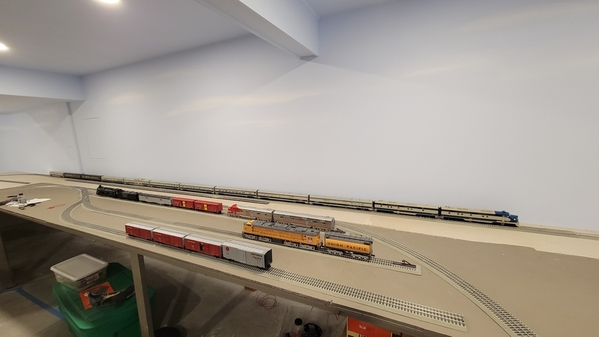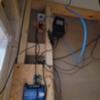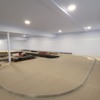@gunrunnerjohn
I have a very odd situation. I am building a new basement layout and decided to put a temporary O96 Fastrack dog bone with 3 O72 switches creating a 3 leg staging ladder. Power supply is a 180 W brick controlled by a Legacy Powermaster. I have a Legacy base and several LCS devices daisy chained driven off the DB9 cable/PDI cable(s). The ground/signal wire from the base goes into a ground bus. From that bus I soldered a wire to the bottom side of the outside rail of a piece of fastrack. The dog bone spans the width of the room approximately 30'. I soldered several hot and ground wires and dropped them down to the corresponding buses under the benchwork. The Legacy base is mounted about 9' off the ground in a central location.
PROBLEM: I have a couple Vision Line stock cars. One of them will NOT respond to commands on the O96 layout. Also, on occasion various engines will blow the whistle WITHOUT the command being input to the CAB2.
When I completely power down the O96 layout (on a dedicated 20 AMP circuit) and take the very same car to my workbench which has its own Legacy Base and a test track powered by a 80W transformer the stock car DOES respond to commands. So the car works.
I have some kind of signal issue on the temporary layout. I have swapped bases...no effect. I have traced all ground wires, not one is tied to the wrong bus. I swapped out the DB9 cable....nothing. I am out of ideas and am coming to the forum for help. There are many members far smarter than I here and I am hoping someone can point me in the right direction.
First we must correct some terminology or else we are going to have one heck of a time trying to get you to troubleshoot this.
The transformers we use in model trains are isolation transformers. The output is completely 100% isolated and not connected to earth ground or the AC neutral coming into the transformer from the wall. Also, we build the track often on wooden insulating tables. The key point is- NOTHING of the track or wiring in general of a layout is true earth "ground". You should avoid using that term to prevent confusion. I try to use the word "Common"- and since this is labeled on many devices- all outside rail of your track, that bus wiring, and the "U" terminal of the transformer is "common".
TMCC or Legacy radio signal is created by the base because the one exception here- the power supply for the base must be plugged into a grounded outlet (3 prong) and this connects the base internal electronics through it's specific and special power supply to earth ground and wiring of your house. The transmit post of the base is connected to common aka "U" and the outside rail of the entire track to form one side of the antenna. Now the important part- the rest of the wiring in your house with earth ground forms the other half of the antenna system for the base to transmit the TMCC signal. Edit- again, they key here, the base is connected to earth ground and all the earth ground wiring inside the walls and structure of your house via the special power supply for the base. It is then creating a radio signal difference- between that earth ground and the U AKA Common post, then connected to the outer rail of your entire layout. So the signal is the difference between your entire layout and wiring, and earth ground wiring inside your house.
Now, the kicker- get ready for upside down and inside out thinking. Your train sits on the track connected to outside rail, connected via common and your bus wiring to the base transmit post. The trains and TMCC action cars all have an antenna placed inside the shell isolated from the frame of the car- because the frame of the car is electrically connected to the wheels in most cases, to outside rail. But you say wait- you just said that the transmit post of the base is connected to outside rail, thus the entire frame of the car is also common at outside rail potential- but what is the antenna receiving?? Again, this is the kicker- ground- true earth ground. The antenna is coupling to all of the ground wiring in your house.
What you have to understand is that the TMCC/Legacy radio receivers are measuring the DIFFERENCE- the difference between 2 potentials- the frame and wheels common- and the difference between that and the antenna coupled to EARTH GROUND.
This is why others mentioned- one test is placing a 3 wire grounded extension cord plugged into a grounded 3 prong outlet, and you run that near or overhead the problem area of your table where TMCC/Legacy reception was a problem. This is what extending the ground plane means- you are placing earth grounded wires or metal and that compared to the common U of the track (which is NOT earth grounded, instead it is isolated by your transformer and the insulating table material, and ONLY connected to the transmit post of the TMCC/Legacy base).
So from all this:
- Ensure the correct power supply is used with your base that came with it and is in fact plugged into an earth grounded outlet.
- Check extension cords or power strips- they can affect this earth ground situation to the base power supply and thus prevent proper earth grounding of the base- seriously affecting transmit and reception of engines and cars.
- Consider placing an earth grounded wire above or near the table and areas -can be an earth grounded extension cord plugged into a 3 prong grounded outlet
- Another test- placing your hand just above but not touching a car or engine that has a TMCC radio reception issue. Your body being made mostly of water acts as a huge ground plane. Remember, the train is trying to receive the difference in potential- between the track outer rails and entire metal frame of the engine- and the antenna coupling to earth ground- or your hand.






















